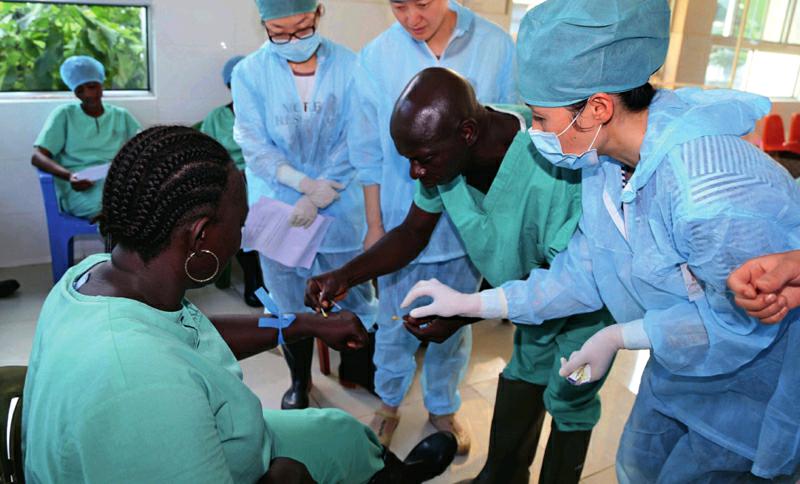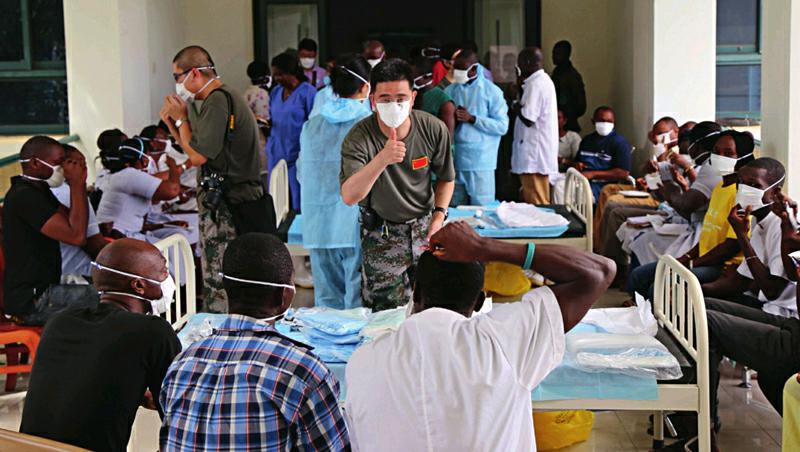Chinese Doctors in Africa
By+staff+reporter+JIAO+FENG
SINCE 1963, when China sent its first medical team to Africa, the country has dispatched more than 20,000 healthcare workers to 69 countries and regions. They have treated 100 million patients. Of the 51 countries in which Chinas 52 medical teams, including 1,200 physicians, are now working, 42 are in Africa. “Chinas selfless aid over the past half century has won it the trust of African countries, laying a solid foundation for the lasting friendship between China and Africa,” deputy head of the International Cooperation Department of the National Health and Family Planning Commission Wang Liji said.
Half a Century of Selfless Aid
Wang Liji recalled that in 1963, when Algeria won independence from French colonial rule, France withdrew all its cooperative projects and technical personnel, including physicians. To fill this gap, the Algerian government sought help from the international community through the International Red Cross. At that time China, having been through three years of natural disasters as well the economic blockade imposed by the West, was still poor and backward. Consequently the Chinese people themselves were in need of medical services and supplies. Nevertheless, under the principle that developing countries should support one another, China immediately mobilized and sent a team comprising 100 of its finest healthcare workers to Algeria.
News of this having spread throughout North Africa, China received requests from elsewhere. It subsequently sent medical teams to 51 African countries.
Besides sending medical teams, China has also provided large quantities of medical supplies. At the Beijing Summit of the China-Africa Cooperation Forum in 2006, then Chinese President Hu Jintao pledged Chinas help to build 30 comprehensive hospitals, and a RMB 300 million grant to build 30 malaria prevention and treatment centers and supply them with the anti-malarial drug artemisinin to combat the disease in Africa. China has since completed construction of 31 comprehensive hospitals and equipped them with the necessary medical facilities and apparatus.
“For more than half a century, despite serious difficulties that have at times arisen at home, China has provided medical supplies free of charge and sent medical teams with no political strings attached. China is the only country in the world to have given such help,”Wang Liji said. “The rapid development of Chinas economy will bring even greater medical aid to other developing countries. We can thus say that China has fulfilled the responsibility of a big country.”endprint
When, in early 2014, Ebola hemorrhagic fever broke out in three West African countries – Guinea, Libya and Sierra Leone – China provided four rounds of emergency aid valued at RMB 750 million, and built Africas first biological safety protection third-level laboratory (P3 Lab). China also sent 16 groups of clinical and public health experts to these countries to carry out large-scale public health training and to strengthen local plague prevention capabilities. Cumulatively, China has sent 27 teams of personnel, exceeding 1,000 person-times.
These plentiful supplies and personnel have been integral to epidemic control, Wang Liji said. Ebola is a highly contagious disease with a mortality rate of almost 60 percent. During the early stages of the epidemic, the infection rate and mortality rate among medical personnel was highest of all.
WHO representative in China Dr. Bernhard Schwartl?nder commended China for taking the lead in 2014 in the global action to combat Ebola in Western Africa. He speaks highly of China.
Chinese Doctor Epithet
Zhai Wenliang is an expert orthopedist and deputy director of the Department of Orthopedics at Military Hospital 175. From January 21, 2013 to January 28, 2014, he was leader of Chinas 16th military medical aid team to Zambia at the Maina Soko Military Hospital, which until then had never had an orthopedic surgeon.
As the hospitals first orthopedic surgeon, Zhai Wenliang proactively coordinated with the hospital in establishing an orthopedic outpatient service and equipping it with standard surgical instruments and apparatus. The orthopedic outpatient service gradually became the “brand name” of the hospital, and the number of its patients grew from five or six to more than 30 a week. During the year Zhai Wenliang spent in Zambia he performed 38 operations, and handled more than 100 emergency cases. After his return to China, Zambias defense ministry awarded Zhais team a medal for international cooperation.
“All doctors in our team come from various big hospitals and are above the rank of attending physicians. Upon arrival in the recipient countries they blend into their hospitals by working in the same manner as local doctors. In the recent decade, we have introduced to Africa first-rate clinical technologies such as cardiac surgery, tumor enucleation, replantation of severed limbs, and minimally invasive surgery,” Wang Liji said.
China now has more than 200 medical stations in Africa, manned by veteran doctors in various fields, including heart disease, surgery, and cardiovasology. In addition to working in local hospitals, they also provide mobile healthcare services to outlying and poverty-stricken areas.endprint

“These doctors must endure tough living and working conditions and face the threat of chaos from war, and also that of infectious diseases, not least AIDS. So far, 51 Chinese doctors have sacrificed their lives. ‘Chinese doctor has consequently become a prestigious epithet in Africa, one that is welcomed and acknowledged among the local populace,” Wang Liji said.
Resident Medical Team
During his 1965 visit to Tanzania Chinese Premier Zhou Enlai met with the Chinese medical team working there. He told them that as, sooner or later, the Chinese medical team would return to China they should train local healthcare personnel, so putting in place a “resident medical team.” Chinese medical teams in recipient countries have accordingly trained considerable numbers of healthcare workers over the past 50 years.
The 16th military medical aid team to Zambia trained a backbone of healthcare workers to attend to local residents. Each team member was responsible for several local doctors. Charlie Sydney, director of the Department of Radiology of Northern Province Military Hospital, is one beneficiary. He was one of five Zambian assistants to a Chinese doctor in the Ultrasound Department of Maina Soko Military Hospital. While working with the Chinese doctor he gained sufficient medical knowledge and clinical experience to be able to work independently. His outstanding performance led to his transfer to the post of director of the Department of Radiology of Northern Province Military Hospital. When- ever his Chinese tutor is mentioned, he sings his praises. Mr. Sydney said he thought his medical knowledge was adequate before working with his Chinese mentor. He then discovered the Chinese doctors depth of knowledge was beyond his imagination. It was that Chinese doctor who helped him to hone his skills and excel in ultrasound.
China is exploring new models of foreign medical aid. In August 2014, China sent a medical team to Trinidad and Tobago. This was a different task in that its objective was to train local healthcare workers and formulate a high-end medical cooperation combining medical treatment, teaching, and research. Local governments in China have also taken new medical aid measures, such as inviting hospital management personnel of recipient countries to their regions, and offering healthcare workers training in China. Under this unified arrangement, China has successfully trained 10,000 community medical personnel and health officials from West African countries. endprint
endprint

